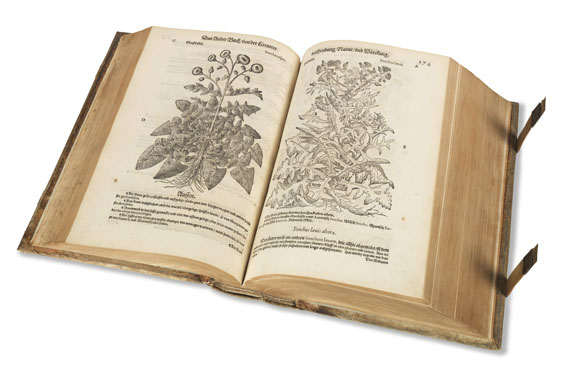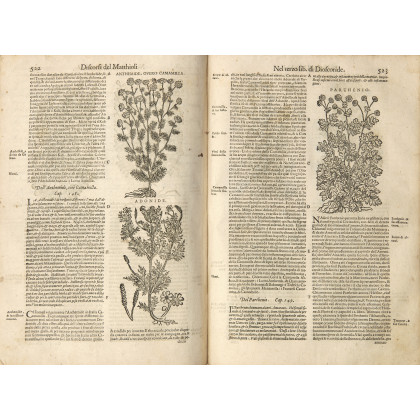Pietro Andrea Mattioli (1500 or 1501-1577) Commentarii in sex libros Pedacii Dioscoridis Anazarbei de medica materia . Venice: Vincenzo Valgrisi, 1565. 2° (345 x 235mm). Letterpress title with woodcut printer's device [cf. Vaccaro p.361]. Woodcut full-page portrait of Mattioli, 1,012 full page-width illustrations, initials and printer's devices on 6G4 v and 6H6 v. (Occasional spotting and browning throughout, some gatherings stained, causing short marginal tears in early gatherings and slight marginal loss in final gathering, short clean tear on Ff4 affecting one line of text, short clean tear affecting headline and 6 lines of text on Ee1.) 18th-century sheep, the spine gilt in compartments with floral and vase tools, gilt leather lettering-piece, red edges (upper hinge partially split, slightly rubbed). 'FIRST ENLARGED EDITION [...] THE 1565 EDITION IS THE FIRST AUGMENTED BY MATTIOLI'S FULLER NOTES AND HAS ALWAYS BEEN THE MOST VALUED FOR ITS COMPLETENESS' (Hunt). Although Mattioli wrote on a range of subjects, and published translations of non-medical works, he is most celebrated for his work on botany and medicine, and of these works his best known are his translations of, and commentaries on, Dioscorides' De medica materia . Mattioli's first Italian translation from the Greek was published in Venice in 1544, and its 'original purpose was relatively modest: it was to provide doctors and apothecaries with a practical treatise in Italian with a commentary that would enable them to identify the medicinal plants mentioned by Dioscorides' ( DSB IX, p.179). Further, expanded editions followed in 1548, 1550 and 1552, and the success of these editions, led Mattioli to translate the work into Latin in 1554. This translation was 'enriched by synonyms in various languages, provided with a special commentary, and accompanied by numerous illustrations valuable for the identification of Dioscorides' simples [which] rendered the work accessible to scholars throughout Europe. From then Mattioli's name was linked with that of Dioscorides' ( DSB IX, p.179). This wealth of additional material transformed Dioscorides' work from an antiquarian text into a contemporary physician's vade mecum , enhanced by Mattioli's own observations and many of his own drawings, which remainded in print virtually continuously until the 18th century. The 1565 edition, described by Brunet as 'la plus estimée', is considered the best for both its illustrations (first used here in a Latin edition), and text. The fine woodcut illustrations extend across the full width of the page: those of plants are by Giorgio Liberale and Wolfgang Meyerpeck (originally cut for Mattioli's New Kretterbuch (Prague: 1563), with the exception of 'Eruca sylvestris') and 'those of the Animals are new' BM(NH). Adams D-672; Arnold Arboretum p.471; BM(NH) III, p.1268; Brunet III, col.1538; Durling 3012; Graesse IV, p.446; Hunt 94; Johnston 93; Nissen BBI 1305; Pritzel 5985; Wellcome I, 4143.
Pietro Andrea Mattioli (1500 or 1501-1577) Commentarii in sex libros Pedacii Dioscoridis Anazarbei de medica materia . Venice: Vincenzo Valgrisi, 1565. 2° (345 x 235mm). Letterpress title with woodcut printer's device [cf. Vaccaro p.361]. Woodcut full-page portrait of Mattioli, 1,012 full page-width illustrations, initials and printer's devices on 6G4 v and 6H6 v. (Occasional spotting and browning throughout, some gatherings stained, causing short marginal tears in early gatherings and slight marginal loss in final gathering, short clean tear on Ff4 affecting one line of text, short clean tear affecting headline and 6 lines of text on Ee1.) 18th-century sheep, the spine gilt in compartments with floral and vase tools, gilt leather lettering-piece, red edges (upper hinge partially split, slightly rubbed). 'FIRST ENLARGED EDITION [...] THE 1565 EDITION IS THE FIRST AUGMENTED BY MATTIOLI'S FULLER NOTES AND HAS ALWAYS BEEN THE MOST VALUED FOR ITS COMPLETENESS' (Hunt). Although Mattioli wrote on a range of subjects, and published translations of non-medical works, he is most celebrated for his work on botany and medicine, and of these works his best known are his translations of, and commentaries on, Dioscorides' De medica materia . Mattioli's first Italian translation from the Greek was published in Venice in 1544, and its 'original purpose was relatively modest: it was to provide doctors and apothecaries with a practical treatise in Italian with a commentary that would enable them to identify the medicinal plants mentioned by Dioscorides' ( DSB IX, p.179). Further, expanded editions followed in 1548, 1550 and 1552, and the success of these editions, led Mattioli to translate the work into Latin in 1554. This translation was 'enriched by synonyms in various languages, provided with a special commentary, and accompanied by numerous illustrations valuable for the identification of Dioscorides' simples [which] rendered the work accessible to scholars throughout Europe. From then Mattioli's name was linked with that of Dioscorides' ( DSB IX, p.179). This wealth of additional material transformed Dioscorides' work from an antiquarian text into a contemporary physician's vade mecum , enhanced by Mattioli's own observations and many of his own drawings, which remainded in print virtually continuously until the 18th century. The 1565 edition, described by Brunet as 'la plus estimée', is considered the best for both its illustrations (first used here in a Latin edition), and text. The fine woodcut illustrations extend across the full width of the page: those of plants are by Giorgio Liberale and Wolfgang Meyerpeck (originally cut for Mattioli's New Kretterbuch (Prague: 1563), with the exception of 'Eruca sylvestris') and 'those of the Animals are new' BM(NH). Adams D-672; Arnold Arboretum p.471; BM(NH) III, p.1268; Brunet III, col.1538; Durling 3012; Graesse IV, p.446; Hunt 94; Johnston 93; Nissen BBI 1305; Pritzel 5985; Wellcome I, 4143.















Testen Sie LotSearch und seine Premium-Features 7 Tage - ohne Kosten!
Lassen Sie sich automatisch über neue Objekte in kommenden Auktionen benachrichtigen.
Suchauftrag anlegen